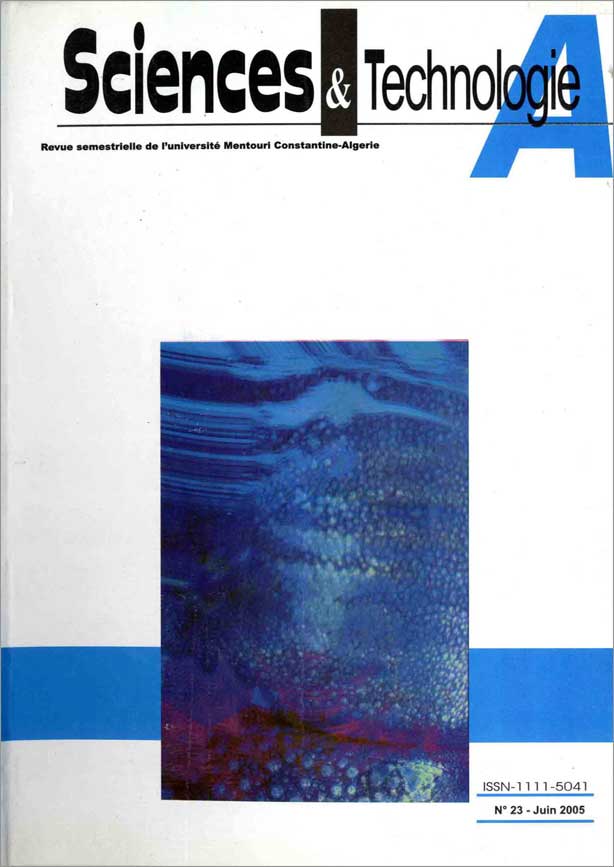±SYNTHESIS OF (±)-1-ACETAMIDO-2, 3-ANHYDRO-4, 5, 6-TRI-O-ACETYL-1-DEOXYMYO- INOSITOL FROM PURE (±)-(1,3/2,4)-1,2,3-TRI-O-ACETYL-4-AZIDO-5- CYCLOHEXENE-1, 2, 3-TRIOL
Keywords:
Azide-coduritol-B, Deoxy-myo-Inositol, Synthèse, O-N acyle migration, 1H-NMR.Abstract
Les deux composés (±)–(1,3/2,4) et (±)–(1,3,4/2)-1,2,3-tri-O-acétyl-4-bromo-5-cyclohexène-1,2,3-triols 3 et 4 ont
été synthétisés par réaction du HBr sur le composé tétraacétate conduritol-B-selon les données de la littérature [1]. Les
produits obtenus sont séparés, pour la première fois, purifiés et caractérisés. La réaction de ces derniers par le triphényl
phosphine dans le THF anhydre conduit aux amines (±)–(1,3,4/2)-1,2,3-tri-O-Acétyl-4-amino-5-cyclohexène-1,2,3-triol
6 et (±)–(1,3/2,4)-1,2,3-tri-O-Acétyl-4-amino-5-cyclohexène-1,2,3-triol 8. Ce dernier est obtenu par un auto
réarrangement interne du composé; le transfert du groupement acétyl de l’atome d’oxygène vers l’atome d’azote conduit
au produit (±)–(1,3/2, 4)-1,2,3-di-O-Acétyl-4-acétamido-5-cyclohexène-1,2,3-triol 9. L’hydrolyse du composé (±)–(1,
3/2, 4)-1,2,3-tri-O-Acétyl-4-azido-5-cyclohexène-1,2,3-triol 7 conduit à l’azide (±)–(1, 3/2, 4)-1,2,3-azido-5-
cyclohexène-1,2,3-triol 10. La réduction à l’aide de triphényl phosphine conduit au composé (±)–(1, 3/2, 4)-1,2,3-azido-
5-cyclohexène-1,2,3-triol 10 et donne le produit (±)–(1, 3/2, 4)-4-amino-5-cyclohexène-1,2,3-triol 11. L’acétylation du
composé 11 à l’aide de l’acide acétique anhydride conduit à la formation de (±)–(1, 3/2, 4)-1,2,3-tri-O-acétyl-4-
acétamido-5-cyclohexène-1,2,3-triol 12 qui donne par oxydation le (±)–1-Acétamido-2,3-anhydro-4,5,6-tri-O-acétyl-1-
déoxy-myo-inositol 13.
Downloads
References
-a- Guo Z-X., Haines A.H., Pyke S.M., Pyke S.G., Taylor
R.J.K., Carbohydrate Research, 264, (1994), pp. 147-153.
-b- Legler G.and Lotz W., Happe-Seyler’s Z. Physiol. Chem,
, (1973), pp. 243-254.
-c- Legler G., Methods Enzymol, 46, (1977), pp. 368-381 (See
especially pp. 380-381).
-d- Trost B.M. & Hembre E.J., Tetrahedron letters,
vol.40.Iss(2), (1999), pp. 219-222.
- Legler G. and Bollhagen R., Carbohydrate Research, 233,
(1992), pp. 113-123.
- Legler G. and Herrchen M., FEBS Letters, 135(1), (1981),
pp. 139-144.
- Lalègerie P., Legler G. and Yon J.M., Biochimie, 64,
(1982), pp. 977-1000.
-a- Johnson C.R. et al., Pure & Applied Chemistry, 64, (1992),
pp. 1115-1120.
-b- Hudlieky T. et al., J.Chem.Soc, Perkin Trans, 1, (1991), pp.
-2917.
-c- Phillipson N., Anson M., Montana J., Taylor R.,
J.Chem.SocPerkin Trans, 1, (1997), p. 2821.
-d- Kwon Y-U., Lee C., Chung S-K., J. Org. Chem., (2002), p.
- Larock C., Comprehensive Organic Transformations, VCH,
Publisher, (1989), p.409 (References their in).
- See for example, R. Abraham and B. Hidson, J.
Chem. Soc. Perkin Transaction, (1956), p.11.
- Fieser M. and Fieser F., Reagents for Organic Synthesis, A.
Wiley Interscience, (1973).
- Murray A. and Reid R., Synthesis, 1, (1985), p.35.
- Nerkajima M., Hasegawa A. and Lichtenthaler F., Chem.
Ber., 96, (1963







